Dress
A cropped jersey top, with shoulder snaps, is combined with a copious suede skirt. Cashin was sympathetic to the body-visibility and body-acuity of the 1970s. Having long been a pioneer, she was as ready to accommodate the body as she was to continue to experiment with the versatility of suede for spring and the uses of practical fasteners. In this ensemble that depends on piping and outlining, the shoulder snaps merely emphasize the design. Big pockets are made evident for the boldness of this design and its sense of self-sufficiency could not be compromised by the etiquette and encumbrance of carrying a handbag. For Cashin, freedom means having your hands free. The story of freedom also extended to footwear. Cashin, McCardell (perhaps the first), Schnurer, and others who advocated pockets also promoted the use of flat shoes and dance slippers. There was a logical correlative to freedom of hands in the deliverance of feet from high heels and hard shoes.
Artwork Details
- Title: Dress
- Designer: Bonnie Cashin (American, Oakland, California 1908–2000 New York)
- Date: spring/summer 1973
- Culture: American
- Medium: (a) wool, leather; (b) leather
- Credit Line: Gift of Helen and Philip Sills Collection of Bonnie Cashin Clothes, 1979
- Object Number: 1979.431.108a, b
- Curatorial Department: The Costume Institute
More Artwork
Research Resources
The Met provides unparalleled resources for research and welcomes an international community of students and scholars. The Met's Open Access API is where creators and researchers can connect to the The Met collection. Open Access data and public domain images are available for unrestricted commercial and noncommercial use without permission or fee.
To request images under copyright and other restrictions, please use this Image Request form.
Feedback
We continue to research and examine historical and cultural context for objects in The Met collection. If you have comments or questions about this object record, please contact us using the form below. The Museum looks forward to receiving your comments.
